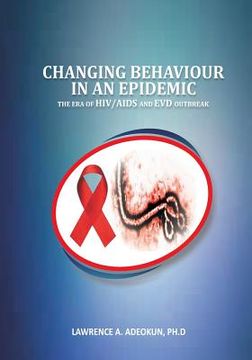Compartir
Changing Behaviour in an Epidemic: The Era of HIV/AIDS and EVD Outbreak (en Inglés)
Lawrence a. Adeokun
(Autor)
·
Createspace Independent Publishing Platform
· Tapa Blanda
Changing Behaviour in an Epidemic: The Era of HIV/AIDS and EVD Outbreak (en Inglés) - Adeokun, Lawrence a.
$ 31.12
$ 43.23
Ahorras: $ 12.10
Elige la lista en la que quieres agregar tu producto o crea una nueva lista
✓ Producto agregado correctamente a la lista de deseos.
Ir a Mis Listas
Origen: Estados Unidos
(Costos de importación incluídos en el precio)
Se enviará desde nuestra bodega entre el
Miércoles 17 de Julio y el
Miércoles 24 de Julio.
Lo recibirás en cualquier lugar de Internacional entre 1 y 3 días hábiles luego del envío.
Reseña del libro "Changing Behaviour in an Epidemic: The Era of HIV/AIDS and EVD Outbreak (en Inglés)"
Behaviours play critical roles in the relationship between health, disease and life expectancy. Behaviours can add or decrease an individual's years of potential life (Green & Kreuter, 1999). In acknowledgment of the significance of behaviour to health, many social scientists have provided different theories on how behaviours are formed and the processes involved in changing them. Most of the existing theories on behaviour change have come from foreign Western authors. Nigerian scholars have made little contributions to the discourse on behaviour change theories. It is therefore commendable that a Nigerian scholar has taken up the difficult task of explaining behaviour change using Nigerian experiences. Here lies the main value of the book titled Changing Behaviour in an Epidemic: the era of HIV/AIDS and EVD outbreak, written by Professor Lawrence Adeokun.The book has four features which make it unique. First, it offers clear and comprehensive processes involved in changing habits and behaviour using relevant examples including drinking of alcohol and smoking of cigarette. The book has also simplified the process of explaining behaviour and how change occurs using easy to understand concepts. Many post-graduate students of Behaviour Change Theory will find the book useful because of the way the author has simplified abstract concepts on how behaviours are formed and changed. Managers of programmes on behaviour change communication will also find the book useful because the examples cited are not mundane but practical. The author made the understanding of these concepts easy by generous use of graphics and Yoruba value and belief system. Secondly, the concepts and ideas developed in the book were derived from the field experiences of the author and his team members during their implementation of several HIV prevention programmes in three Nigerian cities namely Lagos, Ibadan and Ogbomosho in South West, Nigeria. Thirdly, the book offers a comprehensive critique of the existing theories of behaviour change including Kurt Lewins un-Freeze & re-Freeze model, Fishbein and Ajzen's Theory of Planned Behaviour, Rosenstock et. al.'s Health Belief Model, Bandura's Social Learning Theory and Prochaska et. al.'s stages of change. The critique of these theories and the difficulties of making the concepts fit into the Nigerian environment led the author to offer alternative explanations on behaviour. Against the backdrop of the problems of applying existing Western theories into the field experiences in Nigeria the author proposed an alternative explanation called the 4-Staged Intuitive Model of Behaviour Change. The author explained the four stages with questions and actions that individuals take into account in preventing themselves from risk of infection. In the first two stages the individual asks: Is there a Danger? and Am I at risk?. Affirmative answers to these questions lead to stage three where the individual acquires more information and in stage four makes a commitment to practice the new behaviour that will prevent HIV infection. Finally, the contents of the book are evidence-based. Chapter eight is particularly interesting because it shows data of individuals who changed their behaviours in response to the interventions implemented by the Association for Reproductive and Family Health (ARFH) team. The changes in behaviour include having fewer non-permanent partners, condom use, avoiding casual sex and not having extra-marital sex. The non-sexual behaviours changed were: avoiding sharing tools, blood transfusion, non-sterile tools, testing for HIV and eating good food. The chapter also reports evidence of changes in self-efficacy related to HIV prevention including convincing a partner to use a condom.
- 0% (0)
- 0% (0)
- 0% (0)
- 0% (0)
- 0% (0)
Todos los libros de nuestro catálogo son Originales.
El libro está escrito en Inglés.
La encuadernación de esta edición es Tapa Blanda.
✓ Producto agregado correctamente al carro, Ir a Pagar.

